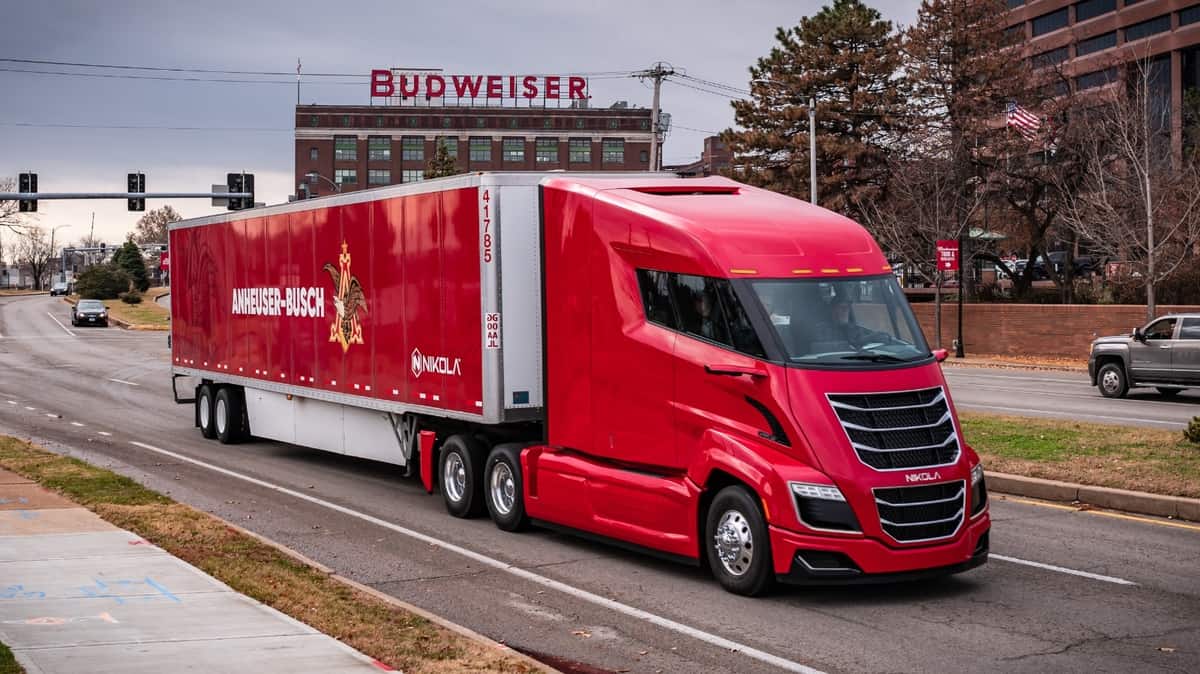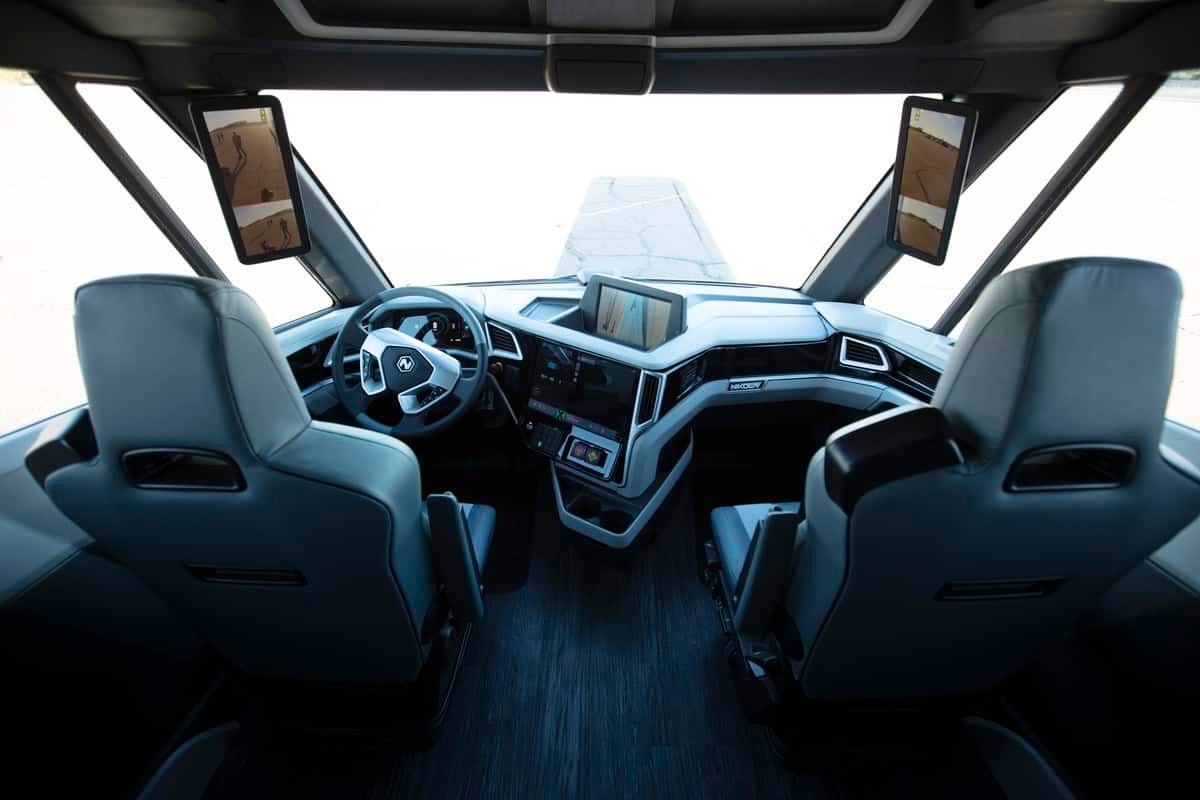The interior of the Nikola Motors Two Class 8 semi-tractor takes cues from modern airplane cockpits with only a handful of buttons and switches. Drivers perform most functions via waterproof touch screens that can withstand a high-pressure hosing.
Nikola so far is noted for its futuristic exterior design and hydrogen-powered fuel cell electric powertrain. The vision is for the trucks to be autonomously driven on highways within a few years of their 2022 launch. Human drivers would take over at Nikola terminals for local deliveries.
The truck, revealed in April 2019, is making the rounds. It dominated the Ryder System Inc. (NYSE: R) display at CES 2020 after appearing at the Bosch stand at the North American Commercial Vehicle Show last October. Both suppliers have major roles with the Phoenix-based startup.
It also made a trial beer run last November in St. Louis for Anheuser-Busch, which has an order for 800 of the trucks.

Pressure wash
To match the sleek exterior, Nikola styled an upscale interior featuring leather seats and metallic accents. But what looks good in a show truck doesn’t necessarily translate to practical daily use.

“There’s some big issues with how clean our truck is for these drivers,” Nikola CEO Trevor Milton told FreightWaves during a tour of the Two at CES 2020 in Las Vegas.
“They’re afraid of spilling ketchup on the suede,” Milton said, recounting feedback from drivers during truck stop visits. “Look, we don’t want nice leather. We want everything to be pressure washable.”
Climbing in
On most trucks, climbing into the cab lands you in the driver’s seat. In the Nikola Two, you arrive behind the driver’s seat next to a wall of storage compartments. Eventually some of that real estate could be used for autonomous driving hardware.
“This whole area can be whatever we want it to be,” Milton said. “The key is to keep it open because it’s your access point and you want it for safety.”
The walk-in door eliminates a cause of driver injury — grabbing a slippery steering wheel as a hoist into the cab.
“What’s really awesome is that it’s away from the seat and the steering wheel, and it allows complete access through the vehicle without climbing over anything,” Milton said.
Frozen chains
The Nikola Two is an extended day cab. Humans won’t drive long-haul miles, so there’s no sleeping bunk. The need for personal storage is minimal.
Drivers told Milton they would like to have a heated area to store tire chains in the winter.
“The problem with the chains is they get wet and turn into a block of ice and they can’t use them,” he said.
They also asked for extra power outlets and areas for clothes and emergency equipment.
Seeing the road
From the driver’s seat, a pair of screens dominate the dash area. The larger of the two at 17 inches handles many functions controlled in more conventional trucks by rows of buttons. Nikola retains buttons for air brakes and emergency parking.

“The idea here was to solve the complexity of a truck,” Milton said. “Before Nikola came along, the cockpit was incredibly complicated. What I wanted to do was simplify the whole thing.”
Milton’s inspiration comes from modern airplane cockpits like the Daher TBM 930 he pilots.
“The new airplanes are very digital in the cockpit to reduce the workload on the pilot. There’s only a few buttons compared to a regular plane that will have hundreds. Everything’s touch screen.”
So, too, the Nikola Two.
Driver feedback about the location of a certain function is addressed by reconfiguring the software instead of “changing an entire lineup of buttons,” Milton said.
Screen colors are identical because they are hypervised, meaning they run on the same computer processor. That speeds boot-up to a couple of seconds versus several minutes in today’s trucks.
The smaller of the two screens provides a view of the front wheels, replacing hood-mounted mirrors that display the truck’s bumper on conventional trucks.
“This will tell you if you’re going to hit a curb or not,” Milton said. “It’s really cool as you drive. You don’t need to worry about your front end anymore because this gives you a shot of it.”
Vertical video monitors, which debuted on the Mercedes-Benz Actros heavy-duty truck in Europe, affix to the A pillars, replacing aerodynamic-defeating side mirrors.
“It gives you a lot better views than a regular mirror,” Milton said. “We’re still going through little tweaks on this to make sure that drivers are happy with the vision and the clarity and the tracking.”
The Nikola Two will have a traditional sun visor at launch, but Milton plans an electronic visor system that would darken the windshield on sunny days like a pair of sunglasses.
“The idea is that it will hit the whole area so it doesn’t distract your eyes,” he said.
Driver education
The many changes inside the Nikola Two take some getting used to.
“The best way to explain this is that it’s like when the first [smart] phones came out and there was a touch screen. Everyone hated it. They’re like, ‘Give me a corded keyboard on my phone,’” Milton said. “It’s a bridge. You have to teach people that it’s OK to use.”


Nikola Ticic
Two words: excellent and outstanding!!! Ready for my augmented reality corneal microchip implant, and my selectively semi permeable anode Piezzoelectric metaloid amalgam US Army truck driver’s glove…
Eli
Would of loved to see more pictures posted in the article. Seems like a nice truck though. These will eventually be the truck of the future.
Eli
Weird, as I’m unable to edit my comment, I guess the article was updated to include pictures, kudos!
Alan Adler
You weren’t the only one who wanted more photos. You were heard.
From The Future
This comment – “Humans won’t drive long-haul miles, so there’s no sleeping bunk.” Mr Milton daydreaming and out of touch with how fast government regulations will come into play on this topic with autonomous commercial vehicles on public roads. Wait until the International Brotherhood of Teamsters gets their saying on this topic, lobbying in DC, putting on strikes and blocking major highways in the US to make people aware of this.
Having a more humble approach and gratitude towards the drivers that brought us here today, that made it possible for Mr Milton to play work and enjoy what he’s doing today is highly recommended.
Noble1
Quote:
“The Nikola Two is an extended day cab. Humans won’t drive long-haul miles, so there’s no sleeping bunk. The need for personal storage is minimal.”
This is not a statement from Mr.Milton . It’s a statement from the “author”
The Nikola two is a day cab , therefore no sleeper . The Nikola One on the other hand is a long haul semi tractor which includes a sleeper berth .
My main issue with these trucks are the lack of doors . It’s nice to have a walk in door , however, it shouldn’t come at the cost of not having a “driver & passenger door” as well , for safety reasons .
In my humble opinion ……………….